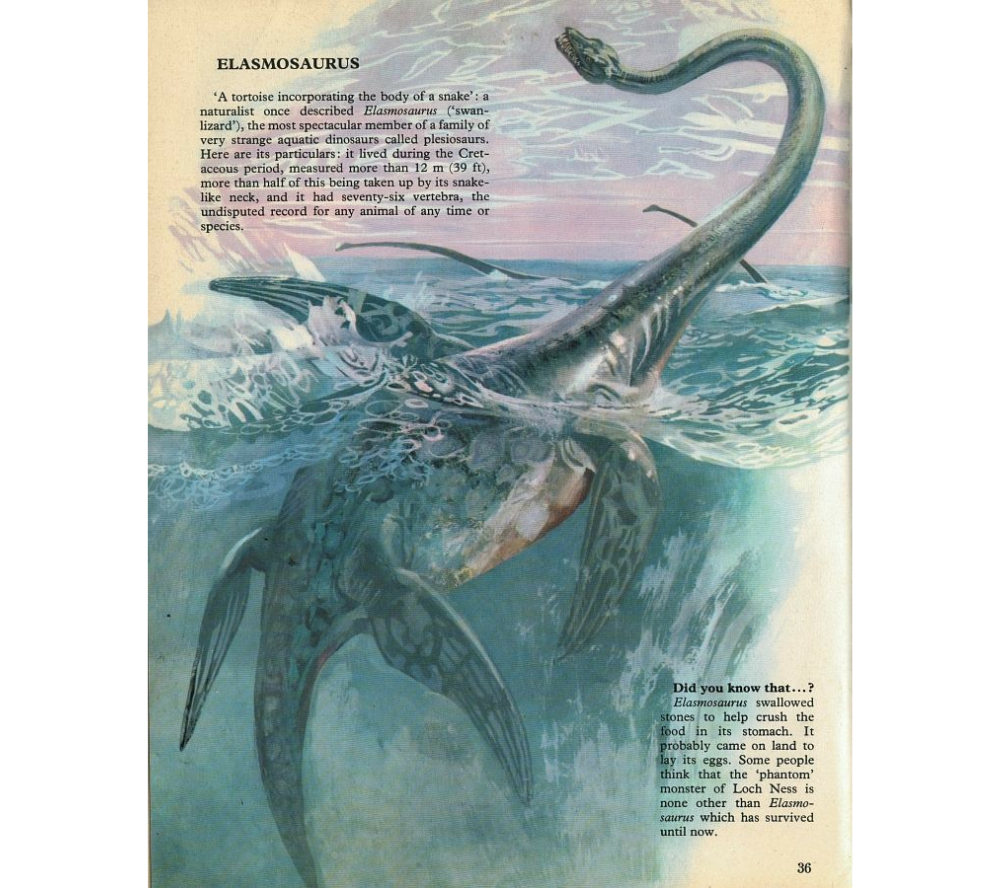Title & Overview
The image showcases Elasmosaurus, an iconic plesiosaur from the Late Cretaceous, renowned for its extraordinarily long neck. The content blends scientific facts with historical anecdotes and pop culture references (like the Loch Ness Monster).

Key Sections & Content
1. Basic Information
-
Name Meaning: “Thin-plate lizard” or “swan-lizard” (referring to its neck vertebrae).
-
Classification: Plesiosaur (marine reptile, not a dinosaur).
-
Time Period: Late Cretaceous (~80 million years ago).
-
Size:
-
Length: 12+ meters (39 ft) — half of which was its neck!
-
Neck Vertebrae: 76 (more than any known animal).
-
2. Anatomy & Adaptations
-
Neck:
-
Extremely long but stiff (limited side-to-side movement).
-
Function: Likely used for ambush hunting, striking fish like a snake.
-
-
Gastroliths: Swallowed stones to aid digestion (common in marine reptiles).
-
Flippers: Four paddle-like limbs for propulsion.
3. Behavior & Ecology
-
Diet: Fish, squid, and other small marine creatures.
-
Reproduction: Misconception Alert – Plesiosaurs gave live birth (no egg-laying!).
-
Loch Ness Myth: Playfully notes the debunked theory that Elasmosaurus survives as “Nessie.”
4. Historical Context
-
Fossil Drama:
-
First discovered in 1868 by Edward Cope, who famously placed the skull on the wrong end (tail instead of neck)!
-
-
Cultural Impact: Inspired sea monster legends worldwide.

Visual Inference
The image likely includes:
-
A full-body illustration emphasizing the neck length.
-
Size comparison (e.g., next to a human diver or boat).
-
Fossil depiction of vertebrae or flippers.
Errors & Improvements
-
Scientific Corrections:
-
Not a dinosaur: Clarify it’s a marine reptile.
-
Live birth: Remove “came on land to lay eggs” (plesiosaurs were viviparous).
-
-
Design Enhancements:
-
Add a timeline (Cretaceous marine ecosystems).
-
Include a vertebrae diagram (showcasing the 76 neck bones).
-
Map: Highlight fossil locations (e.g., Kansas, USA).
-
-
Fun Additions:
-
“Cope’s Blunder”: Show the incorrect skull placement.
-
Prey scene: Elasmosaurus snatching a fish.
-
Why Elasmosaurus Matters
-
Evolutionary Puzzle: How did such a long neck evolve? (Possible answer: niche hunting strategy.)
-
Paleontological Legacy: Its discovery fueled the “Bone Wars” rivalry between Cope and Marsh.
Rating: 8.5/10 (Engaging but needs minor corrections).

Did You Know?
Elasmosaurus’ neck was too stiff to lift out of the water like Loch Ness Monster depictions!
Perfect For: Museum exhibits, marine reptile books, or STEM lessons.
